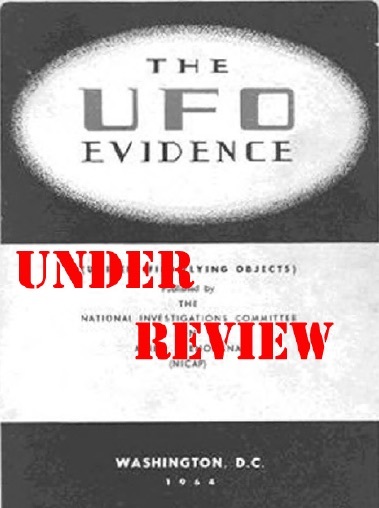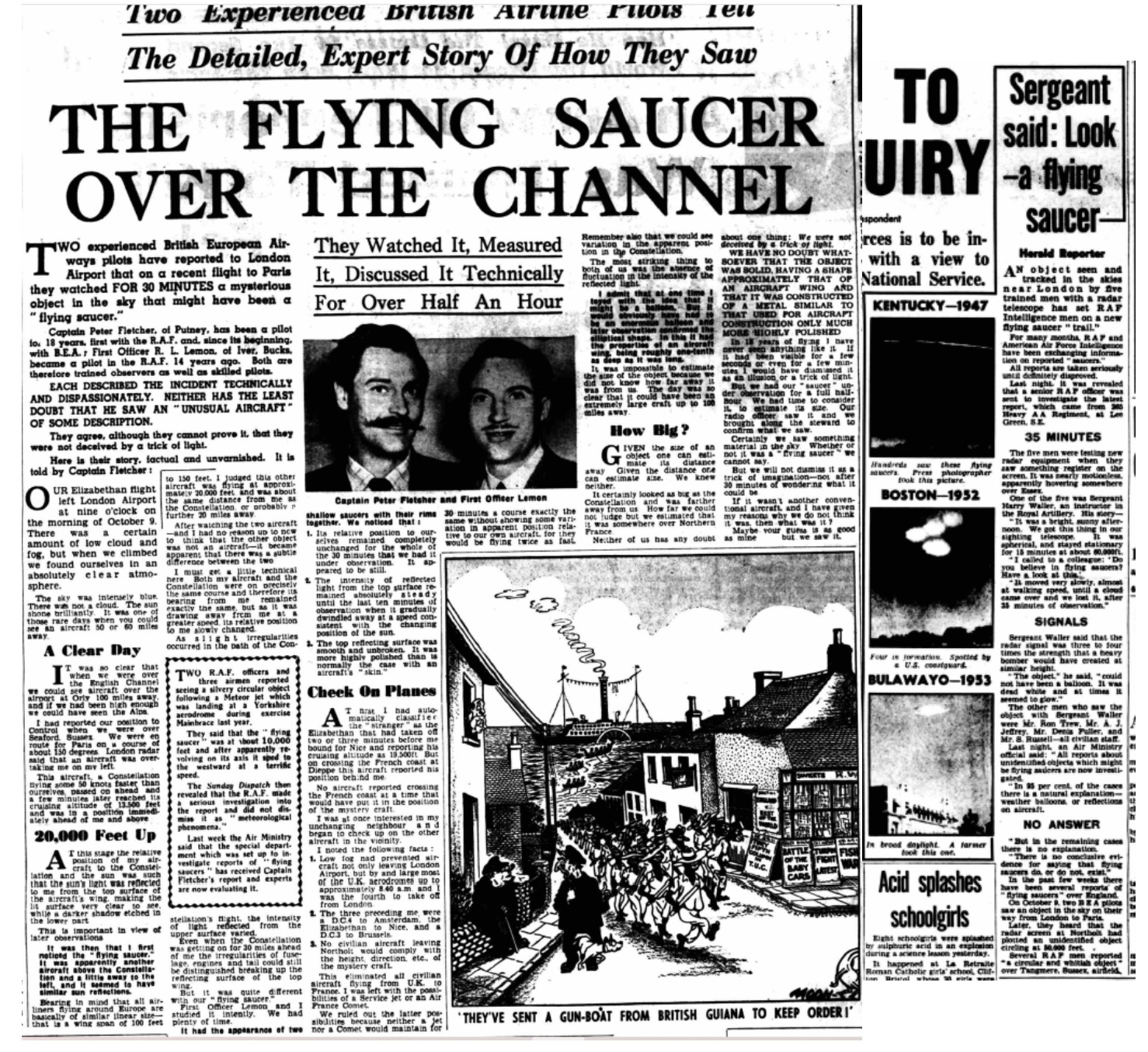6.11.2023

October 18, 1953 - English Channel
October 18, 1953--English Channel. Airline pilots saw a UFO “like two shallow saucers with their rims together.” [V].1
Section V does not elaborate much. It mentions Captain Peter Fletcher and flight officer R. L. Lemon:
UFO “like two shallow saucers with their rims together.”2
The UFO evidence does not provide us with a source of their information.
Additional Sources
The Blue Book files make no mention of the incident. Loren Gross does mention the incident in his UFO history. The only thing is the date was not October 18th but October 9th:
What was parked in the atmosphere high over the English Channel?
Source of report: Airline Captain Peter Fletcher who lived in Putney, England; and First Officer R.L. Lemon of Iver, Bucks, England.
Date: 9 October 1953.
Captain Fletcher took off from London airport and set a course of 150 degrees en route to Paris. The air was so clear Captain Fletcher could make out aircraft traffic over Orly Field, his destination 100 miles to the south.
While flying over the English Channel, London air control notified Captain Fletcher of faster traffic to his left. Looking left, Captain Fletch- er sighted a big Constellation climbing passed him and quickly reaching an altitude well ahead and much higher than his own plane. The Constellation was now cruising at 13,000 feet. Studying the other airliner, Captain Fletcher suddenly caught sight of what he at first thought was “another aircraft,” a bit to the left of the Constellation but much higher, perhaps at 20,000 feet. He estimated that this “other aircraft” and the Constellation were about the same distance away, aside from the height difference, yet while the irregularities of the Constellation’s shape were discernible and were reflecting the strong sunlight, the “other aircraft’s reflecting surface showed no such irregularities. The intensity of the light reflected from the “other aircraft” was steady. Peering closer Captain Fletcher saw ‘that the “other aircraft” had a smooth, polished-like surface, and its shape like that of two shallow saucers, glued rim-to-rim. The “thing” was under ob- servation for some 30 minutes and appeared to be “parked” in the sky.[115]
Footnote 115 states the information came from Bea Mahaffey and Ray Palmer’s magazine/newsletter “Mystic” from March of 1954. The May, 1954 issue of the APRO bulletin contains a summary and also gives the date as 9 October.4
I found a copy of the Mystic magazine article.5 Gross had copied most of the information except the time of day, which was 9AM.
Looking at the Weinstein catalog, there is a listing for October 17, which contains references to this entry in the UFO evidence. Ad- ditionally, there is an entry for October 9th that states there were two BEA pilots over southern England who saw an object that was tracked on ground radar for two hours. Unfortunately, this information apparently comes from the CUFOS/Project 1947 files, which are not readily available. The radar addition is also different. 6 Wikipedia has some source material for this sighting.7 It lists the Daily Herald of November 19, 1953 and Weekly Dispatch of October 18, 1953.
Looking at the British newspaper archive gave me both stories. The October 18 Weekly Dispatch story was the original sighting by Captain Fletcher and First Officer Lemon.8 This probably is where the UFO evidence got their date for the event. They simply listed the date from the weekly newspaper that reported the story. The November 19 Daily Herald story documented another sighting and then made reference to this sighting as well. That mentions that Captain Fletcher later checked about possible radar tracking.9 He stated there was a radar track from Northolt (near Heathrow airport) of an object at 50,000 feet. There is no mention of a two hour duration. I present both articles on the following page. This demonstrates that both Weinstein entries are of the same event and the two BEA pilots mentioned are Fletcher and Lemon.
Analysis
Probably the one thing that stands out about the observations of Captain Fletcher is not the physical description but the state- ment that it was stationary for 30 minutes. This tends to indicate something astronomical, meteorological, or a possible research balloon. The 9AM time indicates the object was illuminated by the sun. In the Weekly Standard article, Captain Fletcher confirmed that it was the sun reflecting off of it that made it noticeable. He also mentioned that it only disappeared when the sun reflection had decreased and the brightness of the object diminished. Captain Fletcher stated he thought it might be a balloon but dismissed this explanation because such a balloon would have to be enormous and the shape (looking like a large aircraft wing) did not look like a balloon.
It is my opinion that Fletcher probably did see a research balloon. Because of the time of day, the balloon’s top surface would have been reflecting light and the lower part was not. This resulted in the observer seeing it as something like a flat semicircle or disc. This might be interpreted as a wing-shaped object. Even the 50,000 foot altitude, where Northolt supposedly tracked their target,is consistent with a research balloon.

The October 18, 1953 Weekly Standard article (above) and the November 19, 1953 Daily Herald article, which mentions the October 9 sighting at the end (above right and right).

Balloons launched from the United States did drift over England and Europe. A Moby Dick balloon, launched on October 26, 1953 from Holloman AFB, was seen and tracked on radar in England. Between October 2nd and October 8, ten balloons were released in the United States.10 Three were accounted for and the other seven were not recovered. This table indicates the balloons launched and their last known position with date.

None of these indicate they made it to Europe. The 10/6 launch was interesting but it had not gone far enough by the 9th. There are two balloons that could have the potential for reaching Europe. These were the balloons launched from St. Paul on the 2nd and 5th.
According to the log, the October 2nd Gopher flight involved a 73 foot diameter balloon with a gross inflation of 574 ft3. The October 5th balloon was for an Office of Naval Research program NA-128 and it was a 92.5 foot diameter balloon that had a gross inflation of 704 ft3.11
The distance from St. Paul to Cherbourg was approximately 4000 miles. One could suggest a travel distance of about 5000 miles. If one assumes the balloon was launched on the morning of the 5th (7-9 AM CST or 1300-1500GMT), the elapsed time would have been roughly 160 hours for the Gopher flight and 90 hours for the ONR flight. The Gopher’s balloon speed would have been about 31mph/27 knots and the ONR flight would have been around 55 mph/48 knots. These are the kinds of speeds one would expect from the jet stream in the upper levels of the atmosphere. However, Stratospheric winds are usually lower speeds than those found in the jet stream.
Unfortunately, the radiosonde data from 1953 only was good up to about 16,000 meters (about 52,000 feet). Project Gopher was designed to fly at a constant level of 21,000 meters (about 70,000 feet).12 One can assume that the ONR balloon would also end up in that region of the stratosphere. Looking at the two Tillamook balloons that flew eastward, on 10/6 and 10/7, they had rough speeds of about 25 knots. More modern balloon radiosonde data goes much higher. I sampled the same range of dates (October 2-5) for 2015 to 2020 for direction of winds/wind speeds at approximately 21,000 meters from Minneapolis, Minnesota

Based on these samples, the numbers indicate that the winds were predominately from the west,northwest, or southwest (average bearing of about 270 degrees) and speeds ranged from 3-41 knots (average of 14.5 knots). These values are similar to those seen from stratospheric speeds of the Tillamook balloons of 1953. While the speeds did reach 41 knots and might have been higher over the ocean, I think these values tend to reduce the possibility that the October 5th balloon could have made it to England. As a result, we can suggest the possibility that the potential source of the balloon was the Gopher launched on 2 October. There were also some balloons launched from Tillamook on September 24th and Vernalis, California on September 27th that might have been the source. These balloons were not recovered and the Tillamook balloon was last recorded being over Pennsylvania on September 26th. However, the best candidate seems to be the Gopher launch from Minnesota on 10/2.
Conclusion
There is the possibility that what was seen was a Project Gopher balloon launched on October 2nd from St. Paul, Minnesota. We can’t prove that this balloon was the source but the description, and behavior, is consistent with a high altitude balloon. There were a few other balloon launches from the United States in the fall of 1953 that might have produced the source. It is important to note that the Stratospheric database is incomplete and it is also possible that a balloon may have been launched from the UK , France, or some other European nation. In my opinion, there is enough circumstantial evidence to classify this case as a “possible high altitude balloon” and remove it from the UFO evidence list and the Weinstein catalog.
Commentary
Since I have been going through all these cases in the Weinstein catalog and UFO evidence document, I continue to be amazed at the sloppy work. It is not unusual to discover that NICAP’s document has the date of an event wrong. This is usually because they simply copy the date of the news clipping instead of actually determining the true date. This document was meant to be pre- sented to politicians with facts about UFOs. How good could the work be if the simple fact of the date an event happened is wrong? The Weinstein catalog is equally guilty of sloppy work. All Weinstein apparently did is merely list a bunch of UFO cases involving pilots. I doubt he event bothered to look closely at the cases. He just copied what others had documented. This case is a perfect example. He listed it twice and still got the NICAP date wrong. It is bad enough that Weinstein padded his list with a bunch of cases that had no dates or times. Now I discover he padded his list with duplicate entries of the same incident! If UFOlogy wants science to take their work seriously, they should stop relying on these documents as evidence of anything. As I pointed out in my article in the book, “The reliability of UFO witness testimony”, UFOlogy needs to set higher standards. They need to make lists that are worth something by only listing cases that have adequate information, have been thoroughly examined, and present compelling evidence. Anything short of that should be classified as garbage.
Quelle: SUNlite 5/2023
